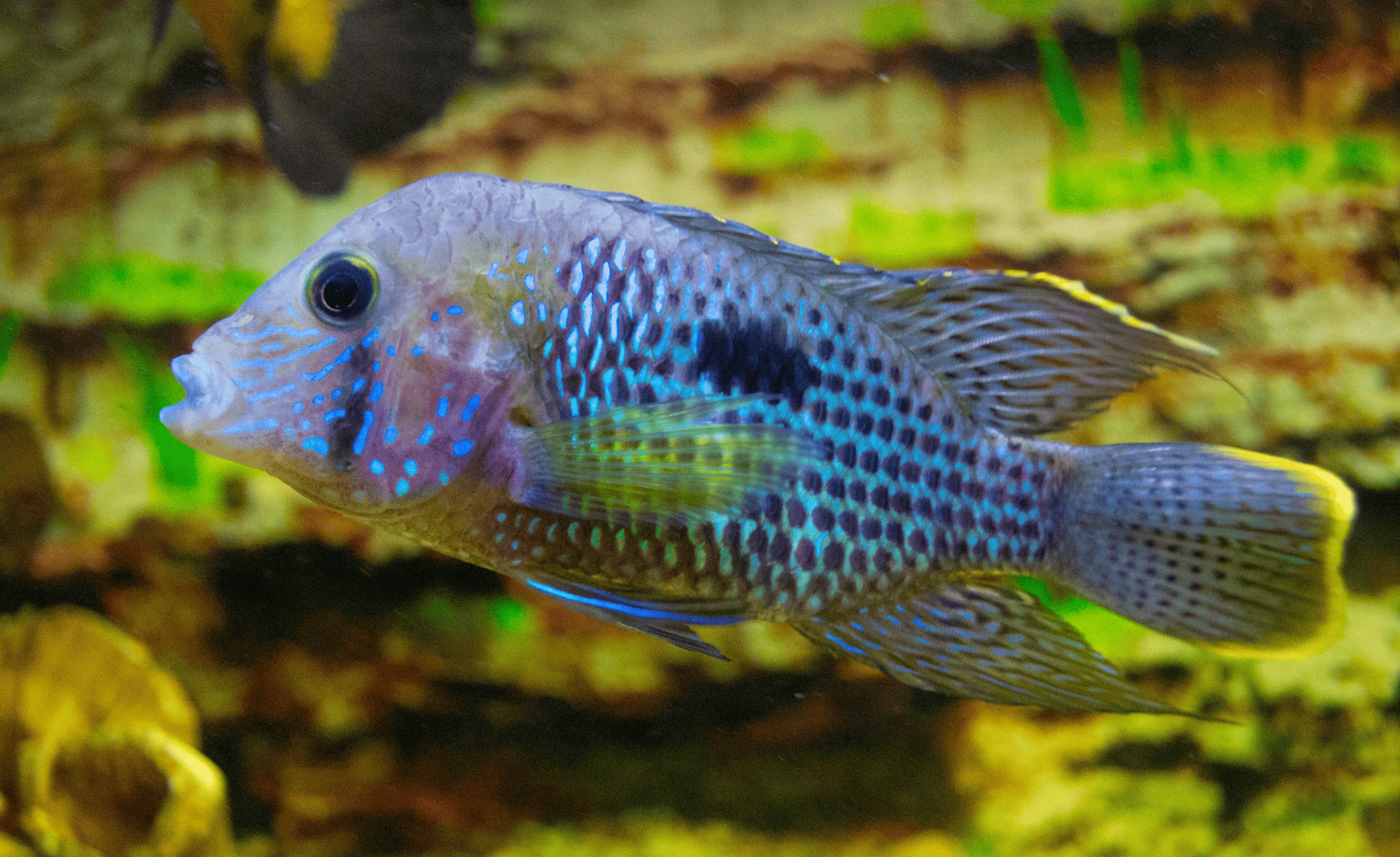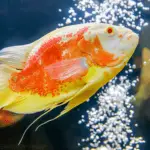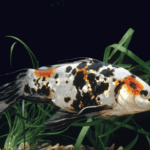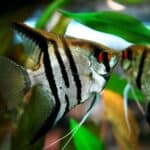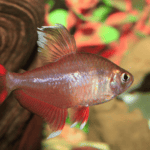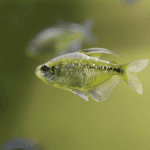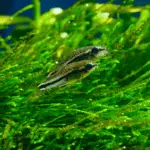The Electric Blue Acara is a stunning freshwater fish that has gained popularity among aquarists for its vibrant coloration and hardy nature. Native to South America, this striking creature is a man-made variation of the regular Blue Acara and belongs to the cichlid family, which comprises more than 1,650 species. This fish’s bright blue body truly shines under aquarium lighting, making it an eye-catching addition to any aquatic environment.
Known for their semi-aggressive temperament, Electric Blue Acaras are best suited to live with peaceful, similarly-sized fish. In captivity, their average lifespan ranges between 8-10 years, but with proper care, they can live even longer. Given their omnivorous diet, these adaptable fish require a balanced mix of dry and wet foods to thrive.
While Electric Blue Acaras are considered beginner-friendly, certain specific parameters need to be met for successful breeding. They cannot tolerate ammonia or nitrite, and they are sensitive to fluctuating water conditions. Consequently, proper management and a stable environment are essential to enjoy the company of these beautiful fish for years to come.
Overview of Electric Blue Acara
Origin
The Electric Blue Acara is a colorful freshwater fish that is native to South America. It is a man-made variation of the regular Blue Acara and has become popular among aquarists due to its stunning appearance and hardiness. The bright blue coloring of its body shimmers under aquarium lighting, making it an attractive choice for many fish enthusiasts.
Scientific Name
The scientific name for Electric Blue Acara is Andinoacara pulcher. It is part of the Cichlidae family, which is related to over 1,650 cichlid species. This fascinating fish has a gradient blue color, starting as sky blue and transitioning to a rich, deep blue shade towards their fins.
Some key facts about Electric Blue Acara include:
- Size: Electric Blue Acaras reach an adult size of 6-8 inches.
- Lifespan: The average lifespan of this fish is between 8-10 years in captivity, and can live double that in the wild.
- Diet: As omnivores, Electric Blue Acaras require a varied diet of both dry and wet foods.
- Tank Mates: They are semi-aggressive and should be kept in an aquarium with peaceful, similarly sized fish.
- Behavior: These fishes are curious and have a passion for burrowing and digging in the substrate, which can sometimes cause a nuisance in a home aquarium, especially if live plants are present in the setup.
By understanding their origin, scientific name, and characteristics, you can ensure proper care for these beautiful fish and create a thriving environment for your Electric Blue Acara.
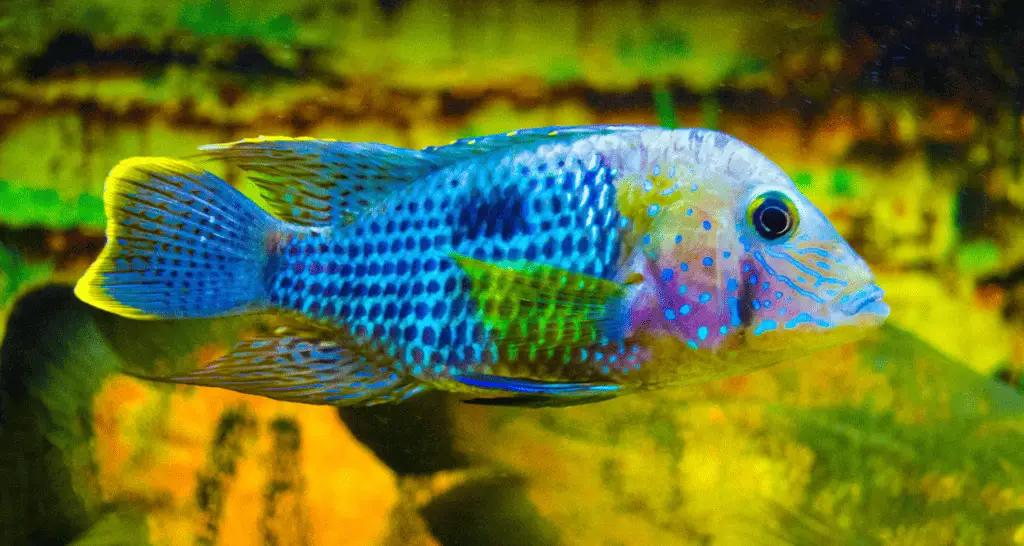
Appearance and Size
Coloration
The Electric Blue Acara is known for its striking iridescent blue color. This mesmerizing coloration gives the fish its name and is one of the reasons for its popularity. Their body is covered in shimmering blue scales that create a gradient effect, starting with a sky blue at the head and transitioning to a darker shade towards the tail.
Body Shape
These fish have a moderately elongated, oval-shaped body with a slightly flattened forehead. An adult Electric Blue Acara reaches a size of 6 to 8 inches in length. Males tend to be longer and more slender compared to females.
Fins
Their fins play a significant role in their appearance. The dorsal fin is quite prominent, extending along the length of the body. Males have a longer and more pointed dorsal fin than females. The anal fins are also noteworthy, with a slightly rounded shape.
In summary, the Electric Blue Acara is a beautiful and unique fish species with a mesmerizing appearance, mainly due to its iridescent blue coloration and distinct fin shapes. With proper care, these fish can thrive in a home aquarium and are truly a sight to behold.
Natural Habitat
Electric Blue Acara are native to South America, where they can be found in various freshwater habitats. These habitats include slow-moving rivers, streams, and lakes, which provide the ideal natural environment for these beautiful fish.
The diverse range of plant species present in their habitat plays a crucial role in providing shelter and breeding grounds for Electric Blue Acaras. Some examples of plants that can be found in their natural habitat include:
- Amazon Swords
- Vallisneria
- Anubias
- Java Ferns
These plants offer hiding spots and allow the fish to establish territories in their environment. Additionally, the water conditions in their habitat typically consist of soft, acidic water with a moderate to strong flow.
Here is a brief information chart about Electric Blue Acara:
| Attribute | Detail |
|---|---|
| Origin | South America |
| Size | Up to 8 inches |
| Lifespan | 5-8 years |
| Water Conditions | Soft, acidic water with moderate to strong flow |
In order to create a suitable environment for Electric Blue Acara in captivity, it’s essential to replicate the conditions found in their natural habitat. This includes providing a planted aquarium with ample hiding spots, maintaining water parameters similar to their natural environment, and generating water flow suitable for their needs.
By understanding and replicating the natural habitat of Electric Blue Acara, you can create an environment that promotes their health, well-being, and longevity.
Aquarium Care
Tank Size and Setup
Electric Blue Acaras require at least a 30-gallon tank for a single fish. Larger tanks are recommended if keeping more than one or if housing them with other species. Ensure there is enough space for swimming and hiding spots, such as caves or rock formations.
Water Conditions
Maintain the following water parameters for a healthy Electric Blue Acara:
- pH: 6.5 – 7.5
- Ammonia: 0 ppm
- Nitrite: 0 ppm
- Nitrate: < 30 ppm
Perform regular water changes to ensure water quality and stable conditions.
Temperature and Hardness
Electric Blue Acaras thrive in water with temperatures between 73°F and 79°F (23°C and 26°C). Keep hardness levels between 3-12° dGH for optimal health.
Substrate and Decorations
Select a substrate like fine sand or small gravel that won’t damage their delicate barbels. Decorate the tank with driftwood, rocks, and caves to offer hiding spots and mimic their natural habitat.
Plants and Lighting
Incorporate live plants into the aquarium setup, such as Java Fern, Anubias, and Vallisneria, as they assist in maintaining water quality and providing additional cover for the fish. Moderate lighting intensity is sufficient to support the plants and satisfy the Electric Blue Acara’s needs.
Filtration and Aeration
A high-quality filter is crucial for maintaining clean water and removing waste. The filter should provide both mechanical and biological filtration. Ensure adequate water movement for oxygenation but avoid excessively strong currents that may stress the fish.
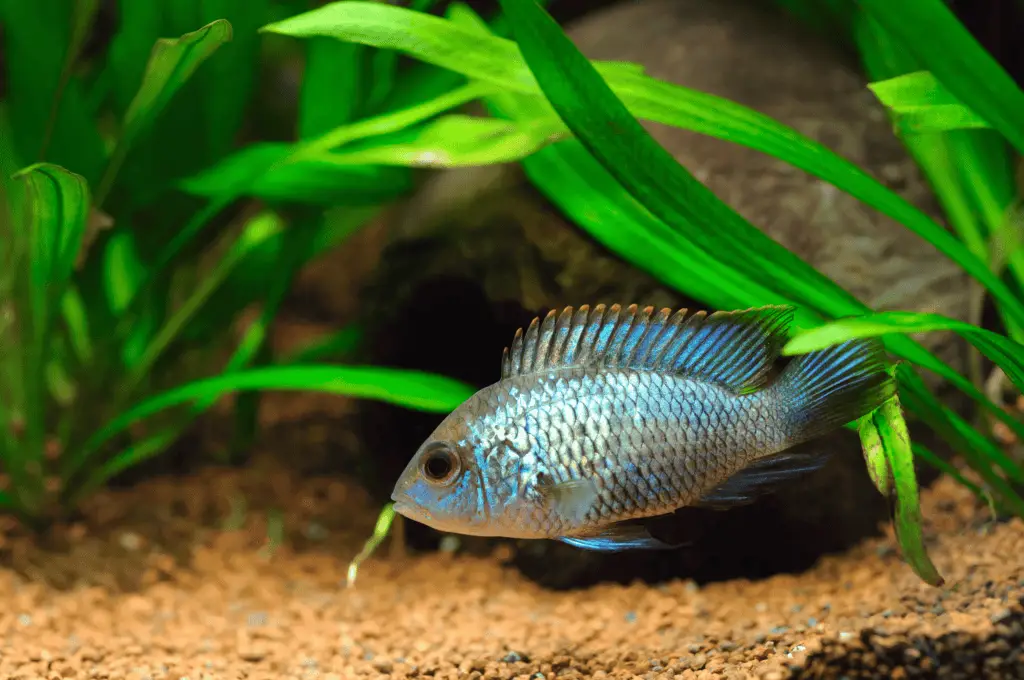
Behavior and Temperament
Compatibility with Tank Mates
Electric Blue Acaras are generally considered peaceful cichlids. They can often do well in community tanks when provided with suitable tank mates. These include:
- Other similarly sized, non-aggressive cichlids
- Larger tetras
- Corydoras catfish
- Plecos
- Livebearers
To ensure compatibility, avoid pairing Electric Blue Acaras with aggressive or fin-nipping species. This will help maintain a calm, stress-free environment within the tank.
Aggression and Calmness
While Electric Blue Acaras are relatively calm in comparison to other cichlids, they can display aggression during breeding, protecting their territory or when confined in limited spaces. To minimize aggressive behavior:
- Provide them with ample swimming space (at least a 30-gallon tank for a single Acara)
- Arrange decorations and plants to create hiding spaces and establish territories
- Maintain stable water conditions (temperature between 72°F to 82°F, pH of 6.5 to 8.0, and moderate water hardness)
By taking these measures, you can ensure a less hostile environment for your Electric Blue Acaras and their tank mates.
Diet and Feeding
Electric Blue Acaras are omnivorous fish that thrive on a balanced and varied diet. Their preferred meals consist of high-quality pellets and flakes, combined with live and frozen foods. To ensure optimal health and coloration, it’s essential to provide the fish with a mix of protein and plant-based foods.
Protein-based Foods
Blue Acaras favor a meat-based diet, which is an excellent source of protein for them. Some of the best protein-rich foods for these fish include:
- Brine shrimp
- Bloodworms
- Daphnia
- Blackworms
Plant-based Foods
In addition to protein, Electric Blue Acaras benefit from consuming plant-based foods. Some good options for incorporating in their diet are:
- Spirulina
- Blanched vegetables like spinach, peas, and broccoli
Feeding Schedule
To prevent overfeeding and ensure their well-being, Electric Blue Acaras should be fed on a consistent schedule. A general guideline is to feed them small amounts two to three times a day, offering only as much food as they can consume within a couple of minutes.
Portion Control
Overfeeding can lead to health complications and uneaten food may cause poor water quality. Make sure to adjust the feeding portions according to the Electric Blue Acaras’ size, age, and activity level. If you notice uneaten food or waste accumulating in the tank, consider reducing the portion size or frequency of feeding.
In summary, Electric Blue Acaras benefit from a varied diet that includes both protein-rich and plant-based foods. Providing these fish with a balanced diet and following a regular feeding schedule will help maintain their health, coloration, and overall well-being.
Breeding and Reproduction
Breeding Tank Setup
To ensure successful breeding of Electric Blue Acaras, it is essential to set up a separate breeding tank. The minimum size for a breeding tank should be 20 gallons. Maintain the temperature within the range of 76-77°F. As for water parameters, keep the pH level between 7 and 7.5 and the water hardness between 12 and 18 dH. It’s a good idea to use an air-powered filter to protect the fry.
Breeding Process
Electric Blue Acaras are relatively easy to breed, and it’s crucial to provide the right environment for them to reproduce without issues. Here are some steps to follow during the breeding process:
- Introduction: Introduce a healthy, mature pair of Electric Blue Acaras into the prepared breeding tank.
- Spawning site: Provide flat surfaces, such as rocks or clean, smooth pieces of wood, for the fish to lay their eggs on.
- Conditioning: Feed the breeding pair with a high-quality diet, including live or frozen foods, to condition them for spawning.
- Monitoring: Keep a close eye on the pair, as they will begin to show signs of readiness, such as increased coloration, territorial behavior, and cleaning their chosen spawning site.
- Spawning: Once ready, the female will lay her eggs on the prepared surface, followed by the male fertilizing them.
- Parental care: Both parents will protect and tend to the eggs, keeping them clean and fanning them with their fins to maintain oxygen levels.
- Hatching: After 3-4 days, the eggs will hatch, and the fry will emerge. At this stage, the fry will feed on their yolk sac for sustenance.
- Feeding fry: When the fry become free-swimming (typically within a week), you can start providing them with appropriate food sources, such as brine shrimp nauplii.
To achieve the best breeding results, maintain excellent water quality and closely observe the behavior of the Electric Blue Acaras. By following these guidelines, you can successfully breed these beautiful freshwater fish.
Health and Lifespan
The Electric Blue Acara is a generally hardy fish with a lifespan of around 8-10 years in captivity. With proper care, their lifespan can extend up to 20 years. In this section, we will discuss some common diseases affecting Electric Blue Acaras and preventive measures to ensure their optimal health.
Common Diseases
Here are a few common diseases that Electric Blue Acaras may face:
-
Ich (White Spot Disease): Small white spots appear on the fish’s body, gills, and fins, causing discomfort and stress. Fish may also exhibit erratic swimming behavior.
-
Fin Rot: This bacterial infection causes the fins to appear ragged and frayed. In severe cases, the infection can spread to the body of the fish, resulting in ulcers and lesions.
-
Scale Protrusion: Fish scales may protrude, giving the appearance of a “pinecone” texture on the body. This can be caused by various infections, including bacterial, fungal, or parasitic issues.
Preventive Measures
To maintain good health and prevent diseases in Electric Blue Acaras, follow these guidelines:
- Water Quality: Maintain clean water, with optimal parameters of:
- Temperature: 72°F-82°F
- Water Hardness: 6-20 dH
- pH Levels: 7-7.5
- Regular Water Changes: Perform regular water changes, ideally 25-30% every two weeks.
- Proper Diet: Provide a balanced, omnivorous diet consisting of a mix of high-quality flakes, pellets, and live or frozen foods.
- Stress Reduction: Ensure a suitable tank size (minimum 30 gallons) and compatible tank mates to reduce stress and territorial conflicts.
- Quarantine: Quarantine new fish before introducing them to the main tank to prevent introducing diseases.
- Prompt Treatment: Treat visible signs of illness immediately with appropriate medications or remedies.
By adhering to these guidelines and maintaining diligent care, you can help ensure that your Electric Blue Acaras live a healthy, long life.
Suitability for Beginners
The Electric Blue Acara is an excellent choice for beginner aquarists due to their hardy nature and adaptability to various water conditions. They are known to be a forgiving species, tolerating imperfections and fluctuating water parameters.
That being said, care should still be taken to maintain a healthy environment for them, as they cannot withstand ammonia or nitrite. Regular monitoring of water quality and maintenance of the filtration system is important to ensure their well-being.
Electric Blue Acaras are relatively peaceful cichlids, making them a suitable addition to community tanks with other non-aggressive fish. This can be a great advantage for beginners, as it allows them to experience keeping a variety of fish species within the same tank.
In terms of feeding, they are not picky eaters, accepting a wide range of foods such as flakes, pellets, frozen foods, and live foods. This makes it easier for beginner aquarists to cater to their dietary needs.
Some factors to consider when setting up a tank for Electric Blue Acaras include:
- Tank size: A minimum of 30 gallons is required for a single fish, with a larger tank preferred if keeping multiple individuals or other tank mates.
- Water conditions: They can adapt to various water conditions; however, their ideal water parameters are a temperature of 72-82°F, pH of 6.5-7.5, and hardness of 3-20 dH.
- Shelter: Provide hiding spots like caves, rocks, and driftwood to mimic their natural habitat and offer a sense of security.
Proper care of Electric Blue Acaras can result in a long and healthy lifespan of 8-10 years in captivity. Ensuring that their basic requirements are met will reward beginners with a vibrant, active, and enjoyable fish to observe and care for.
Popular Variants
The Electric Blue Acara is well-known for its stunning appearance and vibrant colors. It is a man-made variation of the regular Blue Acara, which is native to countries in South America like Colombia and Venezuela. Both species belong to the Cichlidae family and are related to more than 1,650 cichlid species.
While the Electric Blue Acara is a hybrid, it is important to note that it has no other color varieties. Its striking electric blue hue, coupled with shimmering patterns under aquarium lighting, makes it a popular choice among aquarists. In contrast, the Blue Acara sports a darker blue tone with light gray and black bands running over its body, making it visually distinctive from its electric blue counterpart. Additionally, the Blue Acara is known to be more aggressive in nature.
The origin of the Electric Blue Acara remains a topic of debate among fish enthusiasts. Its true lineage is uncertain, as it’s unclear whether this vibrant fish is a selectively bred variant of the Blue Acara or a product of hybridization. Despite these questions, Electric Blue Acaras remain popular for their bold colors, hardy nature, and captivating appearance.
Additional Information
The Electric Blue Acara (scientific name: Andinoacara pulcher) is a freshwater species belonging to the cichlid family, specifically the Cichlidae family. They are native to Central and South America, including countries such as Venezuela and Trinidad. As a man-made variation of the regular blue acara, these fish are known for their vibrant electric blue coloring, making them popular among aquarists.
Caring for an Electric Blue Acara is relatively easy, even for beginners, as this hardy species generally adapts to a variety of tank conditions. However, they cannot tolerate ammonia or nitrite, and breeding may require more specific parameters. The recommended tank size for these fish is 30 gallons, with sufficient swimming space provided. Appropriate tank decorations include driftwood, live plants like Anubias, and rocks.
Here are some key tank conditions to consider for an Electric Blue Acara:
- Temperature: 72-82°F (22-28°C)
- pH: 6.5-8.0
- Hardness: 4-20 dGH
Lighting and aeration should be moderate to mimic their natural habitat. One unique behavior of Electric Blue Acara is their habit of burrowing and digging in the substrate. This behavior helps them find food in the wild, but may cause disturbance in home aquariums, especially if live plants are in the setup.
When it comes to tank mates for Electric Blue Acara, compatibility is essential. Generally, they are peaceful cichlids, making them suitable for community aquariums. However, they might display some aggression, so it is crucial to select suitable tank mates. Recommended tank mates include:
- Oscars
- Bristlenose Pleco
- Rainbowfish
- Gouramis
- Other similar-sized cichlids (avoid the overly-aggressive Green Terror Cichlid)
Please note that while Electric Blue Acara can coexist with discus, this pairing is not recommended due to the distinct water parameter requirements of the discus.
In conclusion, Electric Blue Acara is a beautiful, hardy, and relatively easy-to-care-for fish. By providing proper tank conditions, suitable tank mates, and observing their behaviors, these stunning cichlids can thrive in your aquarium.
